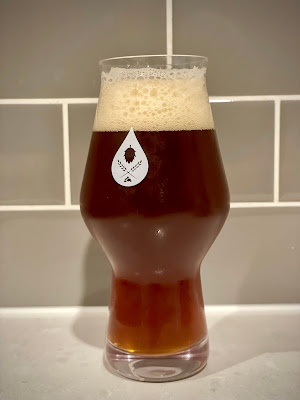Intro
When we set out to design the recipe for this beer, we made a conscious decision to focus on using hops that would give a flavour profile more resinous and piney than outright fruit, or citrus - and that's exactly what we got.
We're very pleased with how this one turned out, and it's not really any surprise, as we researched loads of recipes when putting this one together and found many commonalities in the recipes other people were using and documenting for their American amber ales. Striking the right balance between malt and hop flavours can be tricky in an amber ale, but we feel we've done a pretty good job with this one with both complementing each other nicely and neither dominating the palate.
Here are the links to the Recipe and Brew Day posts
A couple of key things to point out with regards to the recipe;
- Use a tiny amount of pale chocolate malt - we used 50g in total and it really makes a big difference in accentuating the bitterness. Definitely don't use any more than this though as it will quickly overpower everything else at play.
- Don't worry about dry hopping - we were very tempted to dry hop this but we're glad we didn't. One of the articles we read about designing amber ales recipes stated to try and avoid dry hopping and to trust your kettle hops. Obviously you need to make sure you've got some decent late boil (or whirlpool) additions to get the hop flavours you need balanced out against the malt
Appearance
There's a thick, creamy, off-white head that has good staying-power, and as expected underneath it we've got a fairly dark beer in the glass with the Brewfather recipe estimating a colour of 31.5 EBC. It has cleared slightly in the keg after a couple of weeks thanks to the whirlfloc added to the boil, though the darkish colour doesn't make it look particularly clear. It's at the darker end of the colour scale for an Amber ale but still within the acceptable colour range within the BJCP guidelines.
Aroma
Thanks to the classic American hop varieties of columbus, chinook and centennial, we've got a fairly prominent earthy, piney and slightly dank aroma, followed closely by a little bit of sweetness from the malts. There's the tiniest hint of yeast aroma too that we've noticed, but this one smells goood.
Flavour
Mouthfeel as you'd expect is medium to full - since we had a relatively high finishing gravity of 1.014, there's a decent amount of residual sugar left that helps give it the desired sweetness. The hop flavours are very much inline with those listed in aroma and are exactly what you'd expect from the hops used - piney, earthy and a little dank. A little bit of floral and fruit from the centennial hops too. The inclusion of centennial hops in the whirlpool only was a late inclusion but we're glad we added them in - we think it rounds the hop profile out nicely against the chinook and columbus.
Up front there's an initial hit of sweetness, closely followed by the hop flavours, and there's a nice firm but not overpowering bitterness from the hops, which appears to be accentuated somewhat by the pale chocolate malt. There's a nice lingering dryness as well that keeps you coming back for more and more sips. We've upped the carbonation just a touch higher than normal to help ensure the sweetness is kept in check, which it is. There's some interesting flavours coming from the malt - a bit of caramel as you'd expect but this is no caramel bomb. The shepherds delight malt has certainly imparted some interesting flavours likened to licorice and even cola. We're glad we kept the shepherds delight somewhat restrained though as this could very easily take over. The balance in this recipe for us is absolutely spot on.
Conclusion
We're very proud of our American Amber Ale. The hop varieties could be tweaked to adjust the flavour profile if desired to use more new-world hop varieties to impart more citrus and fruit like character, but for us we wanted that classic American piney flavour and it's exactly what we got.






No comments:
Post a Comment